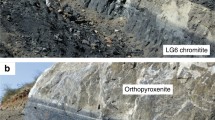Abstract
High-Cr and high-Al podiform chromitites are derived from melts formed by high and low degrees of partial melting in the upper mantle, respectively. The close association of the chromitites, regardless of compositions, with dunites and harzburgites can be explained by interaction between melts and harzburgites or depleted lherzolites in the upper mantle. Continuous reaction between melt and wallrock modifies the compositions of the magmas towards the precipitation of chromite alone under upper mantle conditions. The modified magmas would have higher silica and lower magnesia and would be extracted into the crust or erupted, leaving chromite pods in situ with dunite rinds that grade to harzburgites or lherzolites.
Similar content being viewed by others
References
Arai, S. (1992) Chemistry of chromium spinel in volcanic rocks as a potential guide to magma chemistry, Mineral. Mag. 56:173–184
Bacuta, G.C., Kay, R.W., Gibbs, A.K., Bruce, R.L. (1990) Platinum-group element abundances and distribution in chromite deposits of the Acoje Block, Zambales ophiolite complex, Philippines. J. Geochem. Explor. 37:113–145
Bai, W.-J., Zhou, M.-F., Robinson, P.T. (1993) Possibly diamond-bearing mantle peridotites and podiform chromitites in the Luobusa and Donqiao ophiolites, Tibet. Can. J. Earth Sci. 30: 1650–1659
Barnes, S.J., Naldrett, A.J., Gorton, M.P. (1985) The origin of the fractionation of platinum-group elements in terrestrial magmas. Chem. Geol. 53:303–323
Campbell, I.H., Murck, B.W. (1993) Petrology of the G and H chromitite zones in the Mountain View Area of the Stillwater complex, Montana. J. Petrol. 34:291–316
Dick, H.J.B., Bullen, T. (1984) Chromium spinel as a petrogenetic indicator in abyssal and alpine-type peridotites and spatially associated lavas. Contrib. Mineral. Petrol. 86:54–76
Fisk, M.R. (1986) Basalt-magma interactions with harzburgite and the formation of high magnesium andesites. Geophy. Res. Lett. 13:467–470
Hock, M., Friedrich, G., Pluger, W.L., Wichowski, A. (1986) Refractory- and metallurgical-type chromite ores, Zambales ophiolite, Luzon, Philippines. Mineralium Deposita 21:190–199
Irvine, T.N. (1977) Origin of chromite layers in the Muskox intrusion and other intrusions: a new interpretation. Geol. 5:273–277
Irvine, T.N., Sharpe, M.R. (1986) Magma mixing and the origin of stratiform oxide ore zones in the Bushveld and Stillwater complexes. In: Gallagher, M.J., Ixer, R.A., Neary, C.R., Richard, H.M. (eds.) Metallogeny of basic and ultrabasic rocks. Inst. Mining Metall., London, pp 183–198
Kelemen, P.B., Dick, H.J.B., Quick, J.E. (1992) Formation of harzburgite by pervasive melt/rock reaction in the upper mantle. Nature 358:635–641
Lago, B., Rabinowicz, M., Nicolas, A. (1982) Podiform chromite ore bodies: a genetic model. J. Petrol. 23:103–125
Leblanc, M., Violette, J.F. (1983) Distribution of Al-rich and Cr-rich chromite pods in ophiolites. Econ. Geol. 78:293–301
Leblanc, M., Ceuleneer, G. (1992) Chromite crystallization in a multicellular magma flow: evidence from a chromitite dike in the Oman ophiolite. Lithos 27:231–257
Murck, B.W., Campbell, I.H. (1986) The effects of temperature, oxygen fugacity and melt composition on the behavior of chromium in basic and ultrabasic melts. Geochim. Cosmochim. Acta 50:1871–1887
Pearce, J.A., Lippard, S.J., Roberts, S. (1984) Characteristics and tectonic significance of supra-subduction zone ophiolites. In: Kokelaar, B.P., Howells, M.F. (eds.) Marginal Basin Geology. Geol. Soc. London S pec. Publ. No. 16, pp 77–96
Quick, J.E. (1981) The origin and significance of large, tabular dunite bodies in the Trinity peridotite, Northern California. Contrib. Mineral. Petrol. 78:413–422
Robinson, P.T., Zhou, M.-F., Yang, J.-S, Bai, W.-J., Hu, X.-F. (1993) Tectonic evolution of ophiolites in the Asiatic orogenic belt. GAC/MAC Abstract program, Edmonton
Roeder, P.L., Reynolds, I. (1991) Crystallization of chromite and chromium solubility in basaltic melts. J. Petrol. 32:909–934
Sharpe, M.R. Irvine, T.N., (1983) Melting relations of the two Bushveld chilled margin rocks and implications for the origin of chromitite. Carn. Inst. Wash. Year Book 82:295–300
Thayer, T.P. (1964) Principal features and origin of podiform chromite deposits, and some observations on the Guleman-Soridag district, Turkey. Econ. Geol. 59:1497–1524
Zhou, M.-F., Bai, W.-J. (1992) Chromite deposits in China and their origin. Mineralium Deposita 27:192–199
Author information
Authors and Affiliations
Rights and permissions
About this article
Cite this article
Zhou, M.F., Robinson, P.T. & Bai, W.J. Formation of podiform chromitites by melt/rock interaction in the upper mantle. Mineral. Deposita 29, 98–101 (1994). https://doi.org/10.1007/BF03326400
Received:
Accepted:
Published:
Issue Date:
DOI: https://doi.org/10.1007/BF03326400




